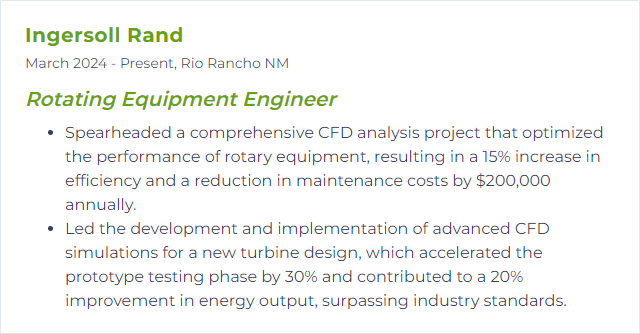Top 12 Rotating Equipment Engineer Skills to Put on Your Resume
Rotating equipment engineering moves fast. Hiring teams scan for proof you can think, diagnose, and build with rigor. The blend matters: fundamentals, tools, and hands‑dirty practicality. The skills below map to what employers expect right now—reliability, safety, performance—so your resume signals you’re ready to deliver.
Rotating Equipment Engineer Skills
- Vibration Analysis
- Tribology
- CAD Software
- FEA Simulation
- Condition Monitoring
- Reliability Engineering
- Pump Selection
- Compressor Design
- Rotordynamics
- Laser Alignment
- Thermodynamics
- CFD Analysis
1. Vibration Analysis
Vibration analysis lets you monitor, interpret, and diagnose machine condition by measuring frequency content, amplitude, and patterns. Done right, it flags imbalance, misalignment, looseness, bearing damage, resonance, and a host of defects before they snowball into downtime.
Why It's Important
Early-warning insight. Less surprise failure. Better reliability, safer operation, and targeted maintenance instead of guesswork.
How to Improve Vibration Analysis Skills
Sharpen both technique and judgment.
Build a solid foundation: refresh signal processing, fault signatures, and machine dynamics; practice FFT, envelope, cepstrum, and time-waveform interpretation.
Use quality data: select the proper accelerometer type and mounting, set correct Fmax and resolution, and follow a consistent acquisition route.
Calibrate and verify: keep sensors and analyzers traceably calibrated; validate measurements with test spectra and known defects.
Integrate with other signals: couple vibration with process, temperature, ultrasound, and oil analysis to triangulate faults.
Trend, don’t just snapshot: set alarm bands, track KPIs (1×, 2×, bearing defect bands), and watch for subtle drifts.
Close the loop: confirm findings in the field (balance, alignment, looseness corrections) and refine your diagnostic rules.
How to Display Vibration Analysis Skills on Your Resume
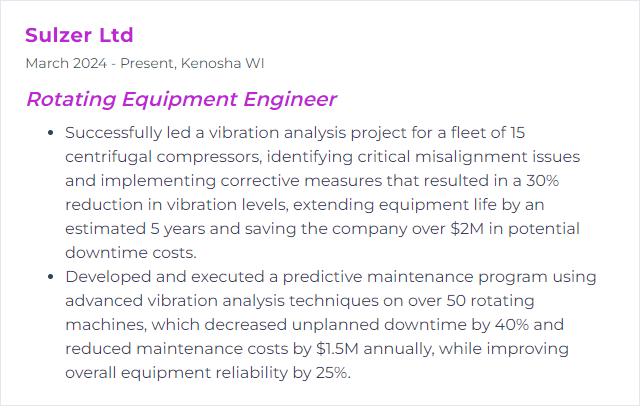
2. Tribology
The science of friction, wear, and lubrication. It underpins bearing life, seal performance, energy losses, and heat generation in rotating machines.
Why It's Important
Lower friction, longer life. Fewer failures, less heat, better efficiency, and cleaner operation.
How to Improve Tribology Skills
Pick the right materials: choose wear-resistant pairs and apply surface treatments or coatings that match the duty.
Get lubrication right: specify grade, viscosity, base oil, and additives for the operating regime; design delivery and cleanliness controls.
Engineer the surface: control roughness, textures, and hardness to manage film formation and contact stress.
Monitor condition: trend particle counts, viscosity, water, and wear metals; respond to lubricant distress early.
Design for load paths: distribute stress, avoid edge loading, and channel lubricant where it’s needed.
How to Display Tribology Skills on Your Resume
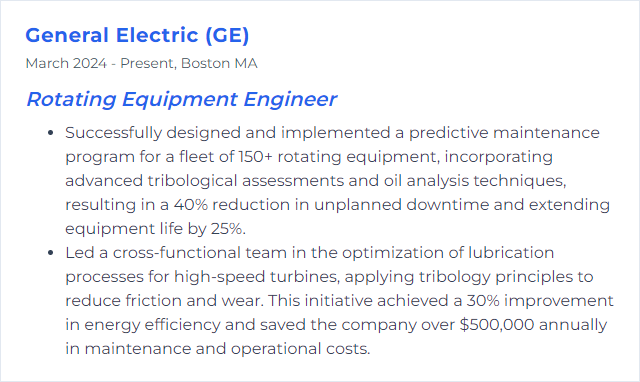
3. CAD Software
CAD turns concepts into precise models and drawings. For rotating equipment, it supports tolerancing, assemblies, interfaces, and rapid iteration.
Why It's Important
Accurate models mean fewer surprises. Better fit, faster manufacturing, tighter compliance, and streamlined change control.
How to Improve CAD Software Skills
Parametric discipline: build robust features, references, and design tables that survive change.
Simulation in the loop: tie models to stress, modal, thermal, and fluid studies to fail early on screen—then fix.
Reusable libraries: standardize bearings, seals, gears, couplings, and fasteners with vetted metadata.
Collaboration and PDM: version control, review workflows, and BOM integrity cut rework.
Templates and drafting: lock in standards for GD&T, notes, surface finishes, and tolerances.
Short feedback cycles: export for CAM/3D print/prototype and loop back design updates fast.
How to Display CAD Software Skills on Your Resume
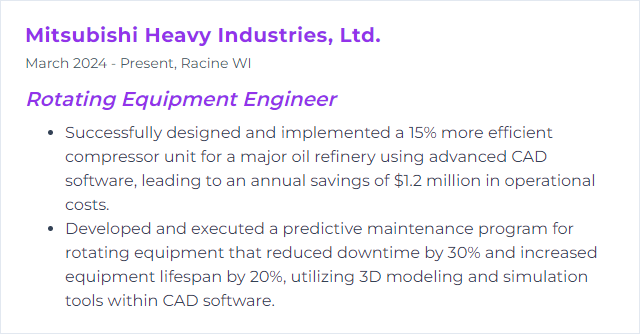
4. FEA Simulation
Finite Element Analysis predicts stresses, deflection, modes, and fatigue risk in casings, rotors, supports, and attachments—under real loads and constraints.
Why It's Important
It exposes weak links before metal is cut. Design confidence rises; iteration costs drop.
How to Improve FEA Simulation Skills
Right-sized mesh: refine in stress raisers and contact zones; keep it coarser elsewhere; check quality metrics.
Trustworthy materials: temperature-dependent properties, damping, S-N curves, creep—use data that matches service conditions.
Boundary realism: replicate constraints, contacts, preload, rotation, pressure, and thermal gradients faithfully.
Solver choice: static vs. modal vs. harmonic vs. transient—match the physics to the question.
V&V: verify with hand calcs and validate against tests; correlate, then iterate.
Sensitivity runs: perturb loads, tolerances, and properties to see what truly matters.
How to Display FEA Simulation Skills on Your Resume
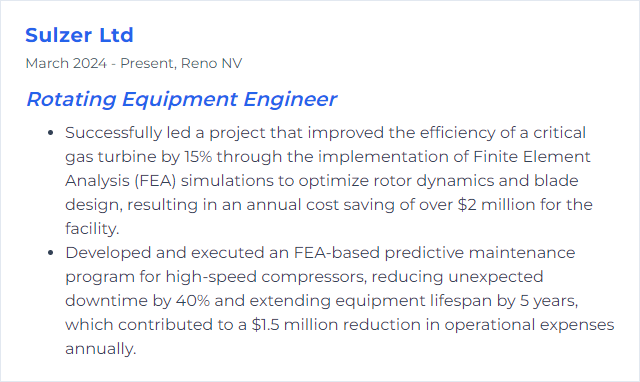
5. Condition Monitoring
Continuous or periodic health checks on pumps, compressors, turbines, and gearboxes using sensors and inspections to spot trouble early and act on it.
Why It's Important
Less downtime, fewer surprises, and safer operations—with maintenance when it’s needed, not just when the calendar says so.
How to Improve Condition Monitoring Skills
Vibration programs: route-based or online systems with clear bands, alarms, and failure modes tracked over time.
Oil analysis: set limits for cleanliness, viscosity, water, acid number, and wear metals; sample consistently.
Thermal scans: trend hotspots, insulation breakdown, and cooling issues.
Ultrasound: detect early-stage lubrication and leak issues beyond vibration reach.
Analytics: centralize data, add rules or ML models, and build alerts that cut through noise.
People and process: train, standardize routes, and ensure findings drive real corrective actions.
How to Display Condition Monitoring Skills on Your Resume

6. Reliability Engineering
Structured methods to keep rotating assets performing over their life: failure modes understood, risks managed, and maintenance aligned with consequences.
Why It's Important
It reduces chronic problems, cuts lifecycle cost, and helps you prove the equipment will do what it must—safely—day after day.
How to Improve Reliability Engineering Skills
Failure modes first: run FMEA/FMECA to rank risks and target controls where they count.
RCM thinking: select tasks (condition-based, time-based, redesign, run-to-failure) by function and criticality.
Root cause rigor: after incidents, apply RCA and implement corrective actions that stick.
Spare parts strategy: stock by criticality and lead time; standardize where practical.
Metrics that matter: track MTBF, MTTR, ACR, and bad actors; review quarterly and adjust plans.
Feedback loop: design, operations, and maintenance share data—then improve the design or the practice.
How to Display Reliability Engineering Skills on Your Resume

7. Pump Selection
Choose the pump type, size, and materials to match fluid properties and system curve—delivering the head and flow with margin, efficiency, and stability.
Why It's Important
Right pump, right point on the curve. Energy savings, fewer cavitation headaches, and longer service life.
How to Improve Pump Selection Skills
Nail the system: define flow, head, temperature, viscosity, vapor pressure, solids, and duty cycle; build the system curve honestly.
Type and hydraulics: match centrifugal vs. positive displacement; target operation near BEP with adequate turndown.
NPSH discipline: ensure NPSHa comfortably exceeds NPSHr across the operating range; control inlet losses.
Materials and seals: select metallurgy, elastomers, and seal plans for corrosion, erosion, and temperature.
Motor and controls: check power across the curve, starting method, and VFD behavior (including minimum flow concerns).
Lifecycle costs: weigh efficiency, maintenance access, spares, and reliability—not just purchase price.
How to Display Pump Selection Skills on Your Resume

8. Compressor Design
Configuration and component choices that safely raise gas pressure with the required flow, efficiency, and operability—within codes and project constraints.
Why It's Important
Good design slashes energy cost, curbs surge risk, and stretches maintenance intervals.
How to Improve Compressor Design Skills
Materials and rotors: select alloys for strength, temperature, and corrosion; manage rotor stiffness and criticals.
Aerodynamics: use CFD and testing to refine blade/volute shapes, clearances, and diffuser geometry.
Thermal architecture: stage design, intercooling, and heat rejection set efficiency and reliability.
Vibration control: modal and harmonic studies to prevent resonance and manage unbalance response.
Manufacturing realities: tolerances, surface finish, and advanced processes (including additive) for repeatability.
Controls and protection: smart antisurge, performance maps, and condition limits that keep you out of the red.
Bearing and seals: pick dry gas or oil seals and bearing types to match speed, load, leakage, and efficiency goals.
Compliance: design to applicable API/ISO and site safety requirements.
How to Display Compressor Design Skills on Your Resume
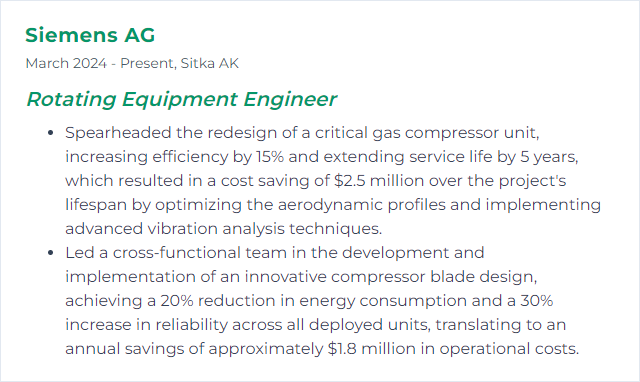
9. Rotordynamics
The behavior of rotating shafts and their supports: critical speeds, stability, whirl, rubs, and how the system responds to forces as speed changes.
Why It's Important
Predicts trouble before it happens. Keeps rotors away from unstable zones and protects bearings and seals.
How to Improve Rotordynamics Skills
Model fidelity: include bearings, seals, supports, anisotropy, cross-coupled stiffness, and damping realistically.
Balance strategies: design balance planes and tolerances; use trim balancing and influence coefficients.
Bearing selection: match fluid-film or rolling-element bearings to load, speed, stiffness, and damping needs.
Damping elements: incorporate squeeze-film dampers, tuned absorbers, or structural damping where justified.
Test correlation: bump tests and runups to validate Campbell diagrams and mode predictions.
Maintenance feedback: trend phase and amplitude; capture events to refine models and set safer operating envelopes.
How to Display Rotordynamics Skills on Your Resume
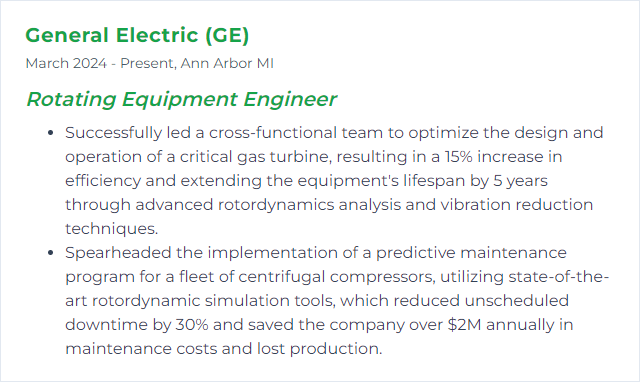
10. Laser Alignment
Precision adjustment of coupled machines so their rotational centers are co-linear under operating conditions.
Why It's Important
It cuts vibration, curbs seal and bearing wear, trims energy use, and prevents premature failures.
How to Improve Laser Alignment Skills
Prepare the base: clean, de-tension pipe strain, level, and verify soft foot before you chase microns.
Mount correctly: secure heads on shafts or hubs; follow recommended rotational methods and measurement points.
Measure and analyze: collect readings through the angle; identify horizontal/vertical and angular/offset components.
Adjust with intent: shim vertically and move horizontally; account for thermal growth and operating alignment targets.
Verify and document: remeasure, confirm within tolerance, and record conditions for future checks.
Recheck after events: any foundation, coupling, or piping work warrants a fresh alignment.
How to Display Laser Alignment Skills on Your Resume
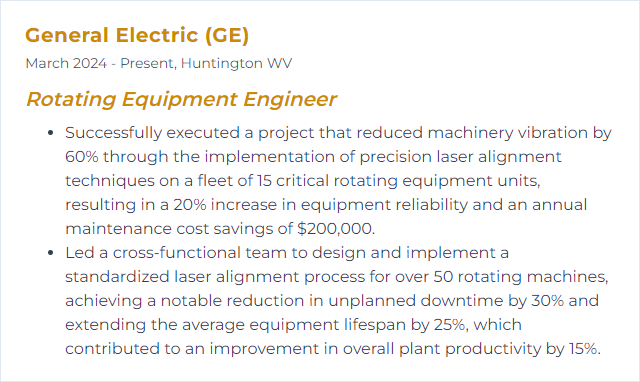
11. Thermodynamics
The rules of energy, heat, and work. For rotating equipment, they dictate efficiency limits, losses, and what temperatures and pressures will do to your machine.
Why It's Important
Without it, you guess. With it, you size, stage, and cool correctly—and squeeze more useful work from every unit of energy.
How to Improve Thermodynamics Skills
Master the laws: first and second laws, entropy, and cycles relevant to your equipment.
Heat transfer savvy: conduction, convection, radiation—plus fins, insulation, and exchanger basics.
Fluids and compressible flow: Mach effects, choking, polytropic vs. isentropic efficiency, and real-gas behavior.
Model and test: tie simulations to measurements, then update assumptions to match reality.
Design with margins: temperature, fouling, and off-design conditions demand headroom.
How to Display Thermodynamics Skills on Your Resume
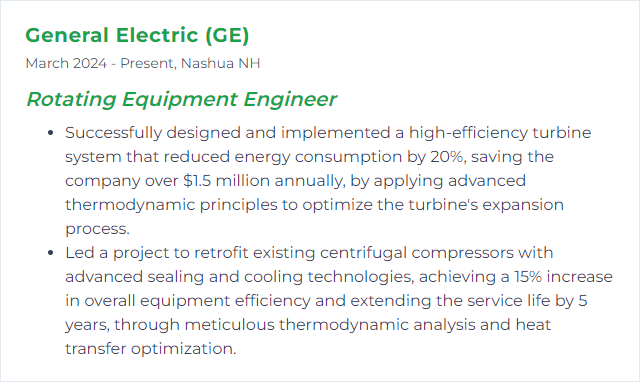
12. CFD Analysis
Numerical simulation of fluid flow and heat transfer in and around rotating parts to predict performance and fix losses before the prototype phase.
Why It's Important
It reveals recirculation, separation, cavitation risk, and thermal issues you can’t see otherwise—so you can redesign with intent.
How to Improve CFD Analysis Skills
Mesh where it matters: refine around blades, gaps, and boundary layers; maintain orthogonality and y+ targets.
Pick the right models: choose turbulence, compressibility, cavitation, and multiphase models that fit your physics.
Handle rotation correctly: use rotating frames or sliding meshes to capture rotor–stator interaction.
Boundary realism: accurate inlets, outlets, wall functions, and roughness; include heat sources and sinks.
Convergence and checks: monitor residuals, forces, and integral quantities; run grid and time-step independence.
Validate: compare with test data; tune only what physics supports, not to force a match.
How to Display CFD Analysis Skills on Your Resume
